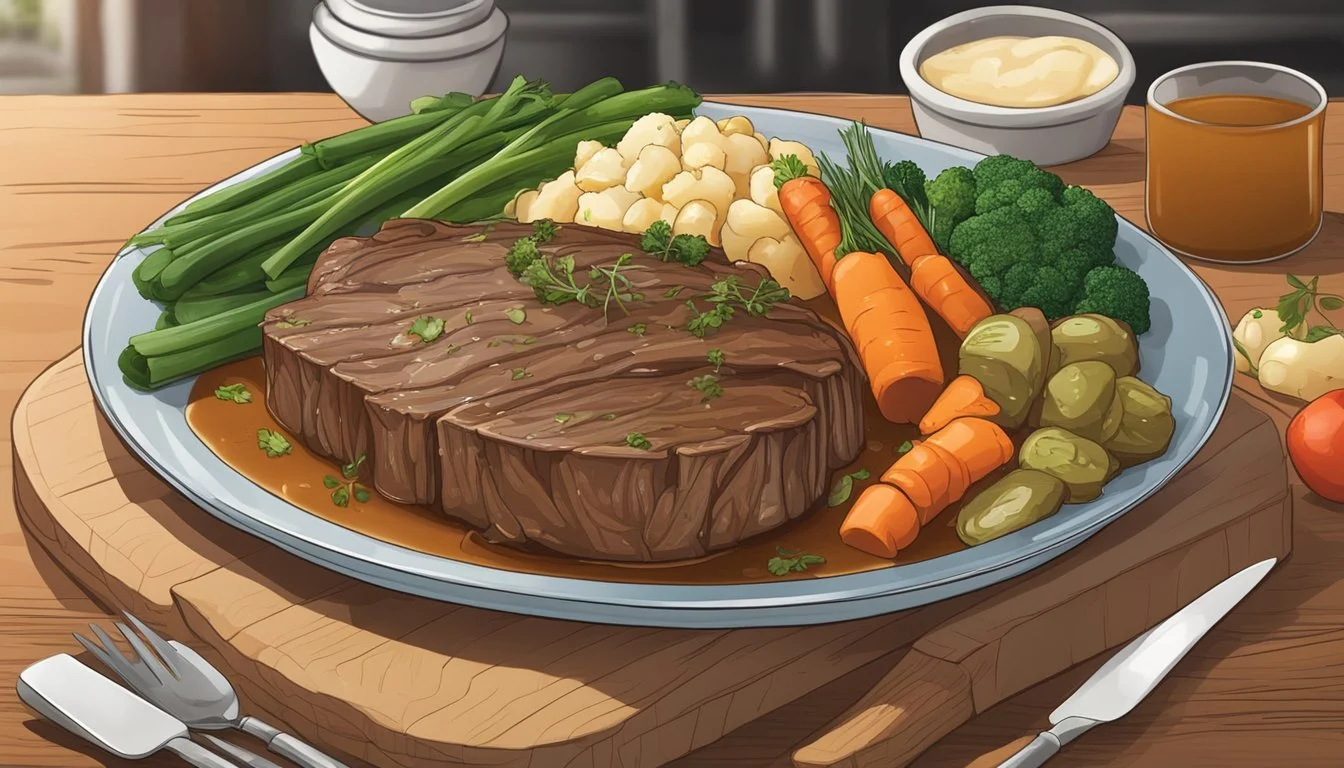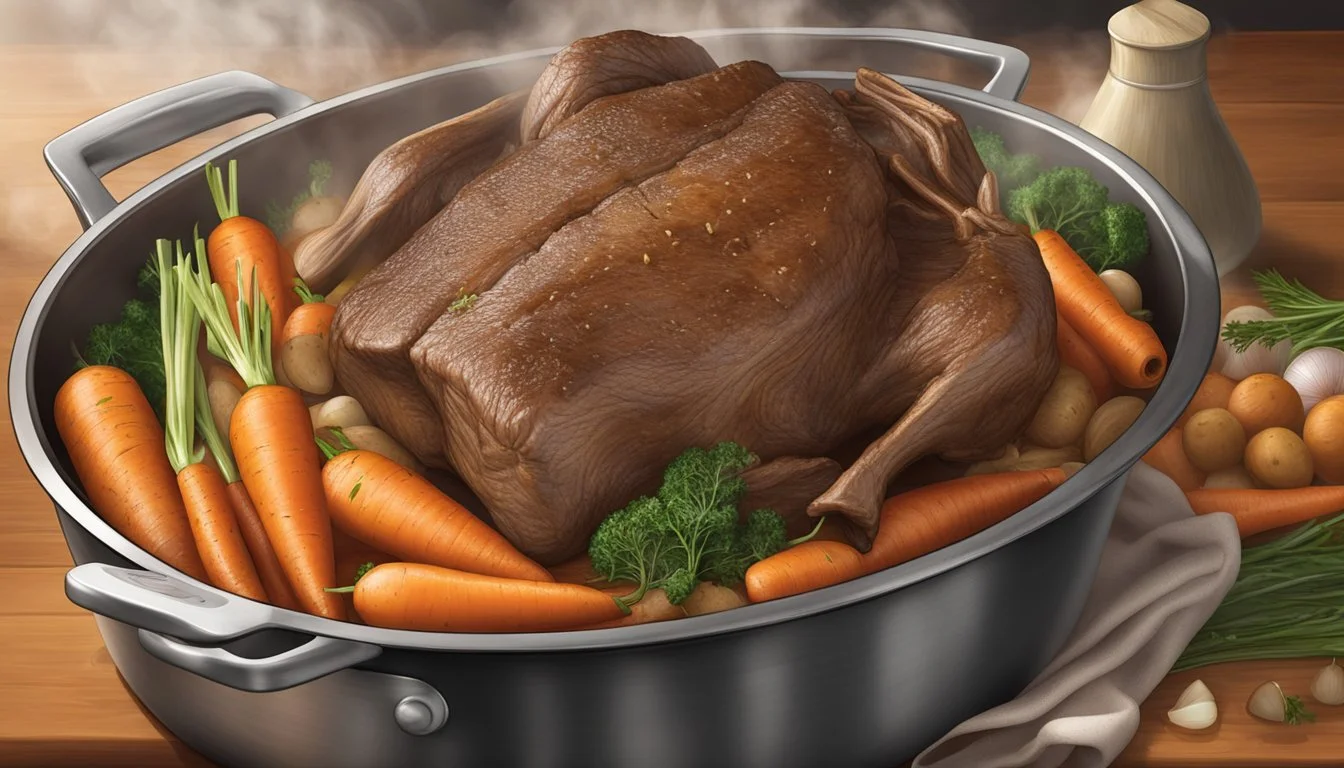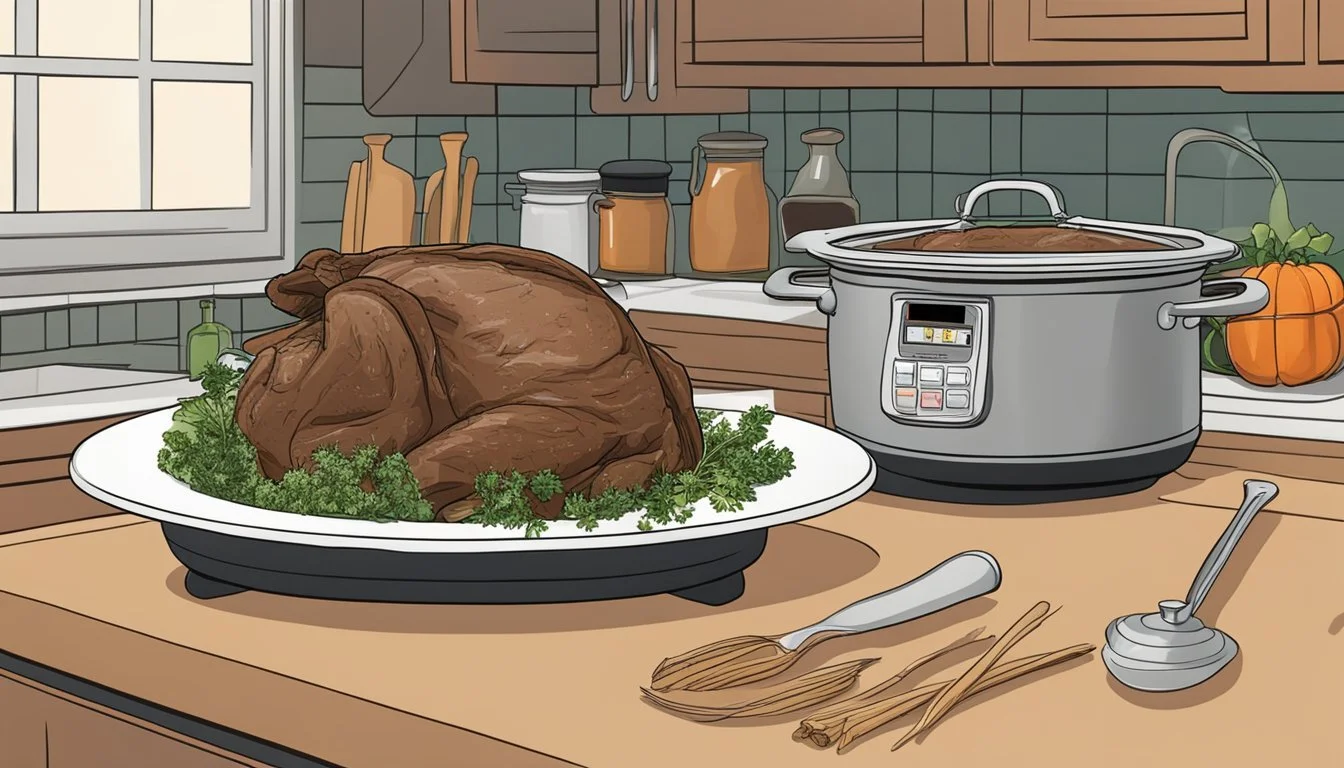How Long Does Beef Pot Roast Last?
Essential Storage Tips
When it comes to classic comfort food, nothing quite compares to a hearty beef pot roast. This main dish, a staple in many households, offers a delicious blend of flavors and aromas, making it a favorite for family dinners. The cooking time for a perfect pot roast can vary, but its appeal is universal.
A cooked beef pot roast typically lasts in the refrigerator for 3 to 4 days, provided it is stored in an airtight container to maintain its freshness and prevent any bacterial growth. This makes it a convenient option for meal prepping, ensuring you have a delectable main dish ready to reheat and enjoy.
Knowing how long your pot roast lasts is crucial for safety and flavor. Whether you're a seasoned cook or a novice in the kitchen, understanding the proper storage techniques will help you make the most of this beloved comfort food.
Beef Pot Roast Basics
A beef pot roast is a classic, slow-cooked dish known for its tender meat and rich flavors. Success hinges on selecting the right cut, using essential ingredients, and following proper cooking methods.
Selecting the Right Cut
Choosing the right cut of beef is essential for a tender pot roast. Chuck roast is a popular choice due to its excellent marbling, which keeps the meat moist. Other suitable cuts include shoulder roast, boneless chuck roast, round roast, and brisket.
Round roast offers a leaner option but might not be as juicy as chuck or brisket. Each cut brings its own texture and flavor, so preference plays a significant role.
Essential Ingredients
Key ingredients for a flavorful beef pot roast include kosher salt, black pepper, and olive oil for seasoning and searing. Carrots, potatoes, and onions add depth and texture.
Common herbs like rosemary and thyme complement the roast. Garlic, worcestershire sauce, and beef broth enhance the savory profile. Some recipes also use garlic powder, vegetable broth, or butter for added richness.
Preparing the Roast
Seasoning the roast is a critical step. Generously apply salt and black pepper to enhance the natural flavors. Browning the roast in hot olive oil helps develop a rich, complex taste.
For best results, sear the meat on all sides until browned. This process locks in juices and forms a delicious crust.
Cooking Methods
Cooking methods for beef pot roast vary. Oven braising is traditional, typically using a Dutch oven. Slow cookers or crock pots are convenient alternatives for hands-off cooking.
Modern options include the Instant Pot or pressure cooker, reducing cooking time significantly. Each method has its benefits, from achieving a fork-tender texture to saving on prep time.
Storage and Shelf Life
Properly stored, a cooked beef pot roast can last up to 4 days in the fridge. Wrap in aluminum foil or place in an airtight container to maintain freshness. For longer storage, freezing is effective.
Divide the roast into portions and freeze in airtight bags, keeping for up to 3 months. Label with dates to track shelf life.
Reheating and Serving
Reheating beef pot roast properly preserves its tenderness. Use gentle heat in the oven, stove-top, or microwave. Add a little liquid like beef broth to prevent drying out.
Serve with gravy or sauce over mashed potatoes, polenta, or alongside roasted vegetables. Enjoy the comforting flavors of this classic main course for days after initial preparation.
Food Safety and Preservation
Ensuring the safety and quality of beef pot roast involves proper storage, identifying signs of spoilage, and understanding how to freeze and thaw the meat effectively.
Proper Storage Techniques
To maintain the freshness and quality of cooked beef pot roast, it should be stored in airtight containers or tightly wrapped in aluminum foil or plastic wrap. This helps retain moisture and prevents exposure to air, which can lead to spoilage. The roast should be placed in the refrigerator within two hours of cooking to avoid bacterial growth. Storing the pot roast in the coldest part of the fridge, usually at or below 40°F (4°C), is also essential for preserving its flavor and tenderness.
Identifying Spoilage
Recognizing spoilage is crucial for food safety. Visual cues, such as discoloration or mold, are clear indicators that the beef pot roast has gone bad. Additionally, any off-putting or sour odors suggest spoilage. The texture of the meat is another indicator; if it feels slimy or sticky, it should be discarded. Consuming spoiled beef pot roast can lead to foodborne illnesses, so it is better to err on the side of caution and discard any meat that shows signs of spoilage.
Freezing and Thawing Protocols
Freezing cooked beef pot roast can extend its shelf life significantly. For the best results, it should be wrapped tightly in plastic wrap or aluminum foil and placed in a freezer-safe container or bag. Labeling with the date helps keep track of how long it has been stored. The pot roast can last up to 2-3 months in the freezer. When thawing, it is recommended to do so in the refrigerator rather than at room temperature to prevent bacterial growth. Allowing the meat to thaw slowly in the fridge ensures it remains within a safe temperature range.
Maximizing Freshness
To maximize the freshness and beef flavor of pot roast leftovers, it is important to control the storage environment. Regularly check the refrigerator’s temperature and minimize exposure to air as much as possible. Slice the pot roast only when ready to serve, as pre-slicing can lead to quicker spoilage. Storing the juices or broth from the pot roast with the meat can also help maintain moisture and enhance the flavor when reheated. Following these practices helps keep the pot roast tender and tasty for the longest time possible.
Nutrition and Dietary Considerations
Beef pot roast offers a rich nutrient profile and can be adapted for various dietary needs. It pairs well with numerous side dishes and can be prepared in multiple ways to suit different tastes and restrictions.
Pot Roast Nutrient Profile
Beef pot roast is a high-protein dish. A typical serving provides significant amounts of protein, essential for muscle repair and growth. Additionally, it contains fat, including some healthy fats when cooked with olive oil.
A 3-ounce serving of cooked pot roast approximately offers:
Calories: 230
Protein: 22 grams
Fat: 15 grams
Collagen: Beneficial for joint health when slow-cooked
Nutrient content varies based on the cut of beef and added ingredients like vegetables.
Dietary Restrictions and Substitutions
Pot roast can be modified to accommodate special diets. For those on a gluten-free diet, ensure to use gluten-free broth and seasonings.
Low-fat versions can be made by trimming visible fat from the beef and using vegetable oil or olive oil sparingly. Vegetarians can substitute beef with hearty vegetables like mushrooms, carrots, and potatoes, or use vegetable broth for a plant-based approach.
Pairings and Serving Suggestions
Common accompaniments include mashed potatoes, carrots, and green beans, enhancing flavor and nutrition. Serve it with polenta or stew for a heartier meal.
For a slightly sweet contrast, corn pairs well with the savory flavors. Red wine is a classic drink pairing, complementing the richness of the beef.
A fresh green salad or steamed green beans can balance the meal by adding a fresh, crisp element.
Recipe Variations and Alternatives
Various recipe variations exist to keep your pot roast interesting. Adding red wine during cooking can add depth and richness to the flavor.
For a thicker sauce, consider using cornstarch as a thickening agent.
Pot roast variations include adding root vegetables like parsnips or sweet potatoes. For a low-carb alternative, omit potatoes and serve with a green vegetable.
For soups and stews, shred leftover beef pot roast and add to vegetable broth with chopped vegetables, creating a nutrient-dense comfort food option.
Culinary Techniques and Tips
When preparing a beef pot roast, mastering certain techniques ensures a tender, flavorful dish. Focus on roasting and braising methods, enhancing flavor through seasoning, and carving meat for presentation.
Roasting and Braising Essentials
Proper roasting and braising are key to making a tender beef pot roast. Start by preheating the oven, typically to around 325°F to 350°F. Season the beef chuck or round roast generously with salt, black pepper, and other preferred spices.
Searing the meat in a hot Dutch oven with olive oil helps in creating a flavorful crust. Once seared, the pot roast should be cooked in braising liquid, such as beef broth or red wine, which breaks down connective tissue and results in a fork-tender texture. Cooking time generally ranges from 2.5 to 3.5 hours depending on the roast size and the recipe used.
Flavor Enhancement
Seasonings and liquid choices play a significant role in flavoring a beef pot roast. Common seasonings include kosher salt, black pepper, rosemary, and bay leaves. Braising liquids like beef broth, wine, or a mixture of both, infuse the meat with additional depth and richness.
Adding vegetables such as carrots and potatoes not only complements the meat but also absorbs the braising flavors, enhancing the overall dish. Alternatively, for extra flavor, a beurre manié (a mixture of butter and flour) can be used to thicken the sauce at the end of the cooking process, creating a rich and creamy gravy.
Meat Carving and Presentation
After cooking, let the beef pot roast rest for about 15 minutes before carving. This allows the juices to redistribute, resulting in a juicier and more flavorful serving. Use a sharp, serrated knife to carve the roast against the grain into thin slices, which helps in achieving a tender bite.
Arrange the slices on a platter, garnishing with the cooked carrots and potatoes. Drizzle with the thickened gravy or sauce for a polished presentation. This meticulous carving and thoughtful presentation contribute to the comfort food’s appeal, making it a standout main course.
Recipe and Preparation FAQs
Beef pot roast is a comforting main dish often prepared with vegetables and seasoned liquids, cooked to tender perfection. Effective preparation requires understanding various cooking methods, suitable ingredient substitutions, the right cookware, and tips for serving and presentation.
Common Cooking Questions
When preparing a beef pot roast, many wonder about the cooking time and temperature. Typically, a 3-4 lb chuck roast should be cooked at 325°F in the oven for about 3-4 hours until it's fork-tender. For a slow cooker, cook on low for 9-10 hours or on high for 4.5-5 hours.
Seasoning is another frequent question. Common seasonings include salt, pepper, garlic, rosemary, thyme, and Worcestershire sauce. Searing the meat in oil before cooking enhances the flavor. When adding vegetables like onions, carrots, and potatoes, include them about an hour before the meat is fully done to prevent overcooking.
Ingredient Substitutions
Substituting ingredients can offer flexibility without compromising flavor. For the beef itself, a chuck roast is classic, but brisket or round roast can work well.
Instead of traditional vegetables like potatoes and carrots, consider parsnips, turnips, or sweet potatoes for a twist. Oil used for searing can be substituted with butter or even bacon fat for a richer taste.
For the liquid, if wine is not preferred, beef broth, chicken broth, or even a combination with beer can add depth. Substitutes for Worcestershire sauce include soy sauce mixed with a bit of balsamic vinegar.
Cookware and Utensil Recommendations
Choosing the right cookware is crucial. A Dutch oven is ideal for its even heat distribution and ability to go from stovetop to oven. An aluminum foil cover ensures moisture retention.
For those preferring convenience, a slow cooker or instant pot can simplify the process. The slow cooker is great for an all-day cook, while the instant pot can cut down cooking time significantly.
Use sturdy utensils like tongs for searing and a large spoon or ladle for serving the gravy. A meat thermometer can help ensure the roast reaches the proper internal temperature of at least 202°F for perfect tenderness.
Serving and Presentation Tips
When serving a beef pot roast, the presentation makes a difference. Lay sliced roast on a large platter, surrounded by vegetables like carrots and potatoes for a rustic look.
Drizzle with gravy made from the pan juices, thickened with a beurre manié or cornstarch slurry. Garnish with fresh herbs like rosemary and thyme for a touch of green and enhanced aroma.
Pair the dish with robust sides such as mashed potatoes or crusty bread. For a touch of elegance, serve with a glass of red wine like Cabernet Sauvignon which complements the richness of the beef. This classic dish can be both a comfort food and a centerpiece for a special meal.






